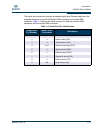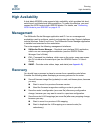
Planning
High Availability
SN0051103-00 A 2-7
A
High Availability
A dual-blade iSR6250 router supports high availability, which provides link-level,
switch-level, and blade-level failure protection. To make this effective, you must
connect the iSCSI hosts to both iSR6250 blades. For details, see “Connecting
iSCSI Hosts to your iSR6250” on page 4-13.
Management
The SANsurfer Router Manager application and CLI run on a management
workstation used to configure, control, and maintain the router. Support platforms
include Windows, Solaris, and Linux. The SANsurfer Router Manager application
is installed and executed on the workstation.
The router supports the following management interfaces:
SANsurfer Router Manager – Graphical user interface (GUI) application,
which runs on a management workstation (see the iSR6200 Router
Manager User's Guide).
CLI – Command line interface, which runs on the router; users can access
the CLI via telnet or the serial port (see the iSR6200 Router CLI User's
Guide).
SNMP – Provides router status, traps, and alerts (see Appendix B).
Recovery
You should have a process in place to recover from a possible router failure.
Consider the following when developing a recovery process for the router:
Save all firmware image files (updates) in a safe, well-known place, because
you may:
Want to revert to a previous firmware version.
Need the firmware image when adding a router to your site.
Save the router’s configuration (as a new file) after every configuration
change, because you may want to revert to a previous configuration.
Save the router’s LUN mappings (as a new file) after every mapping change,
because you may:
Want to revert to a previous LUN mapping.
Want to duplicate the LUN mapping on a second router (for
redundancy).


















